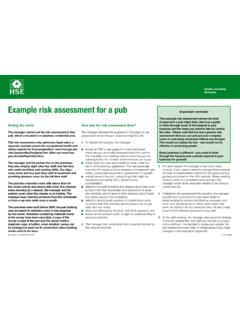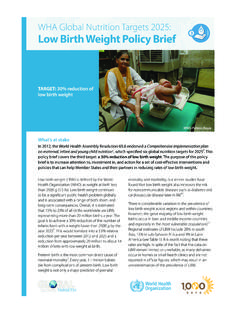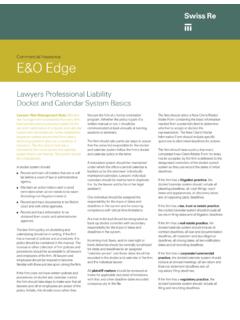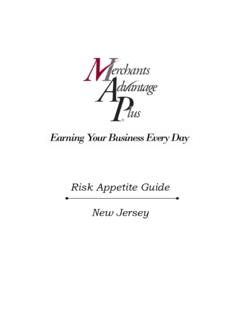Transcription of Risk Assessment Example - Crufts
1 A sample Risk Assessment form is included at the bottom of the section Question: How do I go about undertaking a Risk Assessment ? Answer: By Law, it must be suitable and sufficient' but it must also be simple to understand, implement and communicate to all your staff and contractors .. Step 1 Look for the task/hazards: What equipment, materials and chemicals will be used? How much noise and dirt will there be? What are the ground conditions? What vehicle movements and lifting operations have to be considered? Do you need to schedule a Late Working Rota' to avoid tiredness and accidents? How will you be disposing of waste? Are there any electrical installations? What hazardous vehicles/exhibits do you have? Can visitors fall from a height? Step 2 Decide who could be harmed and how: Who will be affected by your work and most at risk? Think of your employees, contractors or exhibitors on or near your stand, through to the visitors themselves.
2 Safe working depends on co-operation and exchange of information between firms on site, so take this into account and consider necessary precautions on every aspect of work being carried out, which may include training and the provision of relevant information. Step 3: Evaluate the risks and write down Control Measures: Once you have done this adequately, you can then decide on the appropriate action you are going to take to eliminate them. Ask yourself (a) can the hazard or risk be removed completely or done in a different way; (b) if the risk cannot be eliminated, can it be isolated, controlled or reduced and how; (c) can protective measures be taken that will protect the entire workforce on site? Protective work wear should be considered as the last step to take and may not be the only solution. Step 4: Record and notify the findings: Write down the findings of your Risk Assessment .
3 Pass on information about significant risks to take those people identified in Step 2 and record what measures you have taken to control those risks . Write it all down, then do it on site and remember to keep it simple. Step 5: Review your findings: This allows you to learn by experience and take account of any unusual conditions or changes that occur on site. The Stand Manager and/or Principal Contractor should draw up the Risk Assessment as well as a specific Method Statement and go through it with all relevant parties in advance of the Show. Update the Risk Assessment as and when required, such as if new work practices are brought in or new staff employed or the working environment changes in any way. Ordinary hand-written changes are quite acceptable, but remember to implement the changes required for next time. The following Risk Guide should be used in deciding if a significant risk falls into high , Medium or Low category.
4 This information will then need to be transposed next to each significant risk identified for the work activity involved. VERY LOW RISK 1 to 4 requires no action LOW RISK 5 to 7 may require action or creating more awareness, look at specifics MEDIUM RISK 8 to 14 requires action to be programmed over the coming weeks high RISK 15 to 36 requires action immediately The level of detail in the Risk Assessment should be broadly proportionate to the level of risk involved. Risk Guide 1 = Trivial 2 = Minor 3 = Major injury 4 = Major injury 5 = Death to one 6 = Multiple SEVERITY injury/injuries injury/injuries to one person to several person deaths persons PROBABILITY. 1 = Negligible 1 2 3 4 5 6. 2 = Possible 2 4 6 8 10 12. occurrence 3 = Occasional 3 6 9 12 15 18. occurrence 4 = Frequent 4 8 12 16 20 24. occurrence 5 = Regular 5 10 15 20 25 30. occurrence 6 = Common 6 12 18 24 30 36.
5 Occurrence CRU53 Issue 4 Aug -11. Risk Assessment Example Please note that this is an Example only do not return this as your risk Assessment . 2 pages are normal for small stands complex stands may require 20 or more Show: Crufts Venue: National Exhibition Centre, Birmingham Organiser: The Kennel Club To cover show period: Build up, Open and Break Down RA undertaken by: . Exhibiting Company: .. Stand No: .. Stand Name: . Date RA undertaken: .. Signed for Exhibitor: . Signed for Contractor: . Task Hazard Who is at risk? Level of Risk Precaution or Control Measures These are SAMPLE List ALL here none is usually Specify Low, Medium or State existing measures if adequate or new tasks only identify insufficient exhibitors, high (Severity x equipment/work practices if additional Your own! contractors, Probability) precautions need to be taken. visitors, venue staff, young/new staff, children Working at height Falls of men &/or equipment causing Contractors; Medium 1 Hard-hats & harnesses to be worn injuries or death Exhibitors; 2 Temporary guidelines fitted New staff; 3 Only experienced staff are permitted to Venue staff work at height 4 Restrict access by cordoning off areas where there is overhead working 5 Erect warning signs Dogs present on stand Animal distress, bites, scratches, Children; Medium 1 Owners to control dogs infection, allergies Visitors 2 Visitors to ask permission before touching Exhibitors dogs 3 Relevant signage to be provided 4 Only authorised dogs permitted Goods require fork Goods fall from fork-lift resulting in Contractors Medium 1 Ensure that fork-lift operated by trained lifting onto stand crushing, death or damage to Exhibitors personnel.
6 Property New staff 2 Ensure that fork-lift is not over-loaded Venue Staff 3 Allow sufficient time when planning for deliveries to avoid haste. Display lights used at a Burns to people or property touching Children Medium 1 Fit guard. low level bulb/fitting Visitors 2 Position out of reach of children Exhibitors 3 Fit warning sign Selling/displaying Injury/death caused by Children high 1 Have relevant COSHH Forms pharmaceuticals on swallowing/inhaling Visitors 2 Keep products out of reach of children stands Exhibitors 3 Products to be kept secure Venue Staff Use of hooks or sharp Injury caused by accidental collision Children Medium 1 Position all display racks on stand, thinking rails to display shock Visitors about the expected flow of visitors. Exhibitors 2 Any hooks or sharp edges to be blunted Venue Staff and highlighted using hazard tape. 3 No object to obstruct at eye-level.
7 CRU53 Issue 4 Aug -11.





